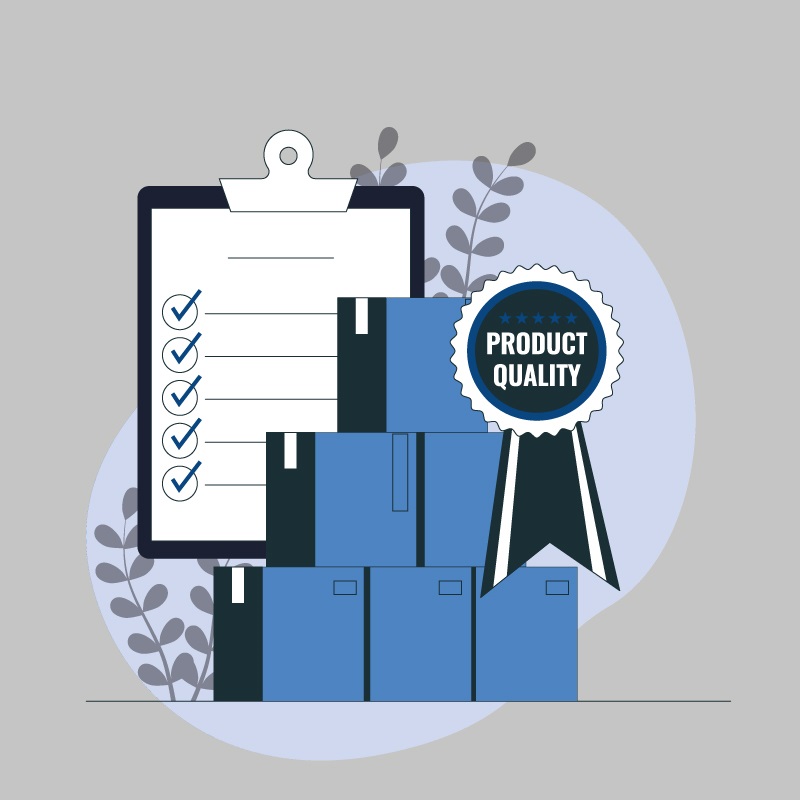
Running an Amazon competitor analysis is crucial to your success in the marketplace. Using a framework to monitor your adversaries’ efforts is a great way to ensure you can beat them at their own game.
Amazon earns nearly $17 million every hour. A portion of those earnings goes to Amazon sellers, product manufacturers, and fulfillment partners. However, the competition among these players is fierce.
According to Statista, of Amazon’s 2.5 million sellers, 10% make over $100,000, and 1% generate over $1 million in sales per year. Top sellers continually monitor market strategies to get ahead on Amazon.
To compete with the top players, sellers must be aware of their competitor’s strategies. An Amazon competitor analysis involves conducting keyword research, comparing product pages, and much more. The information you learn from analysis helps you improve your Amazon marketing.
Why analyzing your competitors is important
Your competitors are constantly bringing new products to the market. With millions of sellers vying for attention, it can be difficult to drive enough traffic to your brand’s products. And if that wasn’t enough, converting that traffic and making sales can be a bigger challenge.
Every seller needs to optimize their listings with Amazon SEO. However, updating product listings alone is not enough to win a competitive edge on this ecommerce platform. Instead, you must have an understanding of Amazon competitor analysis if you want to get ahead.
Nearly 300,000 new sellers join the platform each year. Bringing attention to your brand’s products requires a long-term strategy and a framework to help you achieve your goals.
This guide explains how you can use the same strategies as your competition to improve your Amazon sales. It takes a lot of work, but it will help increase your click-through rate, drive conversions, and optimize your listings.
Fundamentals of an Amazon competitor analysis
The competitive analysis involves thorough research of your competitors. This includes identifying who your competition will be, as well as their marketing strategies, products, and more.
The point of conducting a competitive analysis is to scope out your competition and gather vital information. For example, what are your competitors doing right? How can you improve your own business strategies, as well as setting yourself up as solid competition?

An analysis of your competitor’s business will also help you to identify where they are falling short. Checking through their customer reviews may help you notice flaws or gaps in their business, which could be something you and your business could fill.
Measuring your competitor’s success will also give you something to work towards. You know who you need to outperform, and hopefully, after a competitive analysis, you will know how to do it.
What does this mean for a seller looking to conduct a competitive analysis? For a start, briefly checking through your competitor’s website and scrolling through their social media feed does not qualify as a proper competitive analysis! To collect real and helpful information, you will need to go deeper.
How a competitor analysis can give you the edge
There are four main points you will need to work towards in a competitive analysis:
- Discover new market trends – how can you better sell your product?
- Streamline your marketing and selling habits – this is something you can always improve.
- Identify gaps in the market – remember, if you have noticed these gaps, chances are, so will your competitors.
- Work towards developing new services and products – the market is constantly changing, and you and your business must adapt along with it.
As mentioned earlier, a proper competitive analysis involves more than just checking your competitor’s website, social media and reading a few customer reviews. While these are important steps that can collect useful information, you will need to do more. A thorough analysis may take time and effort, but it is worth it.

Photo by Scopio from NounProject.com
Start by identifying your competitors. Once you’ve done this, you need to research their products. What do they offer that you don’t, or vice versa? How do they sell their product or services, and what success are they having?
1) Pricing and marketing: yours vs. your competitors
A simple yet obvious aspect of analyzing are your prices. Compare yours with your competitors, including costs like shipping. Are your prices competitive? How do your marketing strategies compare?
2) How your competitors use social media
Never underestimate the powerful effect social media can have to promote a business or a product. How active are your competitors on social media? What kind of traffic and engagement do they receive on their websites?
3) Understand your own brand positioning
An Amazon competitor analysis always starts from who you are as a brand first and what you might offer that they don’t. This is part of an exercise to document your brand positioning efforts.
Since proper brand positioning is so important, let’s take a few moments to consider the fundamentals: for example, what does it mean to create a brand position? What will be the consequences if you don’t?
What is brand positioning?

A brand identity can make or break a product. It involves careful marketing, cleverly telling a story, and creating a “vibe” around that product. This distinguishes the product from its competitors and often makes customers loyal, preferring that brand above all others.
Proper brand positioning involves creating this identity. It doesn’t happen overnight and requires you to analyze all aspects of your product carefully, including the packaging, the social media, the advertising, font, colors, and more. Every detail matters.
Why is brand positioning important for Amazon sellers?
Getting a customer’s attention on the Amazon marketplace is not easy. Millions of sellers clog the site with countless products. If you want your product to get noticed, a strong brand identity is essential.
If you feel that your product hasn’t had a proper brand identity up until now, it’s certainly not too late. With work and strategy, you can market your product to stand out on Amazon. Working on your brand positioning helps you determine how to market Amazon products.
A strong brand identity can also work away from Amazon. It’s something you can (and should) carry into all aspects of your product’s promotion. However, since Amazon is currently the juggernaut of online selling, it’s good to first concentrate on proper brand positioning.
What are the various types of brand positioning strategies?
There are many ways to position your brand identity properly. Many sellers use a combination of both, but it can largely depend on you and your product. It’s important to think about what you’re selling and who your customers are.
There are six main types of brand positioning:
Value positioning
Affordability, or value or money, is a good way to appeal to more customers. People like to think they’re getting good value for their money, and you will likely attract more buyers.
Quality positioning
Conversely, you might create a high-priced product with the benefits of durability, high quality, and perhaps even an investment idea. A high-priced product may not attract the same number of customers as a lower-priced one, but you will have the advantage of needing to sell fewer items to make the same profit.
Problem & solution positioning
There may be a current problem that your product can help to solve. This involves listening to your customers and staying alert to current trends. Ideally, you create a solution that stands the test of time.
Benefit & convenience positioning
People love items that can make their lives easier. Marketing an item that can give a customer extra time or smooth a difficult chore can be very lucrative.
Celebrity positioning
Using a well-loved and familiar famous face to promote your product can go a long way.
Competitor positioning
Competition is healthy. Playing up your own brand against a competitor’s is a popular strategy, but beware. The best product will win – let’s hope it’s yours!
How is brand positioning related to an Amazon competitive analysis?
Essentially, you will not be the only seller offering that kind of product. If you’re offering eco-friendly makeup and skincare, for example, there will be other sellers who offer the same or similar products.
These are your competitors, and it’s important to highlight to customers the difference between your products and theirs.
You might choose a different brand positioning strategy or simply create a different brand identity. What do you have that your competitors don’t? How do your products match up?
Competitive positioning is part of your reaction to your Amazon competitor analysis. You’ll discover valuable information about your competitor’s sales, marketing, products, and brand position strategy in your analysis.
Now it’s up to you to highlight your products’ differences, making your brand seem more attractive to potential customers.
4) Analyzing competitors against your strengths & weaknesses
Based on your positioning, you can assess whether your brand (including your products) is competitive. You can also identify the areas that need the most work.
While the day-to-day requirements of running your business can be all-consuming, remember to keep the ‘big picture’ in mind. Your business always needs to be moving forward, so you need to be looking ahead. For this, you’ll need a SWOT analysis.
A SWOT analysis is a tool used by businesses to analyze this current situation. It focuses on Strengths, Weaknesses, Opportunities, and Threats, hence the acronym.
Strengths: These are internal things that are good for your business and help in achieving your objective. Ask yourself about your advantages, your resources, and so on.
Weaknesses: These are internal things that are harmful to you and your business. This includes what you perceive as your own weaknesses, as well as what customers and competitors would consider weaknesses. This may take some frank self-examination, but it’s necessary to make changes.
Opportunities: These are external factors that you cannot control but could lead to good things for you and your business. However, could you put your business in the way of opportunities? What can you do to help yourself in this regard?
Threats: Again, these are external factors that you have little or no control over, but they may damage your business. These could include new regulations that will impact your business, rising costs, more competitors, and more. What can you do in the way of damage control?
Conducting a SWOT analysis is easier than you think. Below is an example of the kind of graph you could use:

What are the benefits of a SWOT analysis?
Simply put, a business requires a lot of moving parts, especially on a thriving platform such as Amazon. Neglecting the big picture means that your business will struggle.
Some benefits of regular SWOT analyzing on yourself and competitors include:
- Fully understanding your businesses’ strengths and weaknesses, as well as being able to prepare for opportunities and possible threats.
- Forewarned is forearmed: you can prepare in advance for what might come your way, adjusting your business as you go.
- You will be aware of your competitor’s SWOT statistics, meaning you can prepare for possible threats as well as keeping your brand separate.
- Having a clear grasp of the big picture means that you and your business will continue moving in the right direction, expanding, and making progress.
Now that you have a better understanding of your business strengths, weaknesses, opportunities, and threats, let’s a framework for analyzing the competition.
5) Amazon ecosystem use & performance

Amazon’s ecosystem is unique in that it has specifics to look at, such as Buy Box percentage, a range of Sponsored Ad products, A+ content, keywords, and more. This is all accounted for in our Amazon ecosystem analysis framework.
Product listings
Reviewing all aspects of your competitor’s product listings, including titles, descriptions, and A+ content, and more. Are they going after particular product features or use cases? Are they majoring on particular themes, e.g. organic, made in USA, etc.? Are they employing certain Amazon badges? What is their Buy Box percentage? Are they FBM or FBA? Compare them with your own.
Product images
Check the competitor’s product images. Your product needs a suitable, attractive image. Shoppers tend to scan lists, and a poor or inaccurate image will have them skipping right over the listing. Can you beat the competition with better product images?
Keywords
It’s important to keep an eye on what keywords your competitors are using. If you’re selling the same product, you’re likely using the same keywords. Which keywords are your competitors using? What is their strategy? What ad campaigns are they using for certain keywords? Are they getting more success or less while focusing on those keywords?
As well as relative organic and paid performance on relevant keywords, when you’re auditing your competitor’s product listing, keep an eye out for keywords used in the titles.
Reviews
Customers will leave honest feedback on a product’s listing page. Are your competitor’s customers dissatisfied or delighted? If they’re unhappy, what’s the problem? Is there a gap that you and your product could fill?
Q&A sections
Review your competitor’s Q&A sections. Many shoppers check this section before making a purchase. By identifying new questions on competitor’s product listings, you can improve your own. Which questions do customers ask your competitor often?
Customer research
Try and determine your competitor’s angle. Who are they are selling to, and how are they doing this? Do your brands clash? It could be that you are taking a completely different approach to sell the same product as your competitor.
Prices & promotions
All sellers need to make a profit. But you may get many more customers by selling at a lower price than your competitor – while still making a profit. You can estimate their profit by how much inventory they move each month. Of course, this is a guideline, not a rule.
Your Amazon presence deserves to be unique
Competitors will always try to steal your market share but the difference between those who succeed in defending against this and those who lose market share to competitors is down to how well they understand their competition and then how they respond.
With millions of Amazon sellers, it’s likely that some of your competition are selling very similar products to yours, but with the size of Amazon’s Marketplace(s) there is still an abundance of opportunity for you, as long as you find ways to stand out.
Your business can benefit from an understanding of your and your competitors’ brand positioning, SWOT analysis, and Amazon approach.
At Emplicit we use our team of subject matter experts to conduct high-quality competitor analysis and generate actionable insights. We can then help develop and implement strategies to maximize your Amazon sales and protect your brand.

